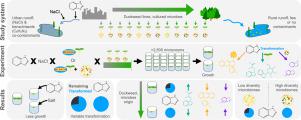Water Research ( IF 11.4 ) Pub Date : 2022-07-31 , DOI: 10.1016/j.watres.2022.118926 Anna M O'Brien 1 , Zhu Hao Yu 2 , Clara Pencer 3 , Megan E Frederickson 3 , Gregory H LeFevre 4 , Elodie Passeport 5

|
Urbanization impacts land, air, and water, creating environmental gradients between cities and rural areas. Urban stormwater delivers myriad co-occurring, understudied, and mostly unregulated contaminants to aquatic ecosystems, causing a pollution gradient. Recipient ecosystems host interacting species that can affect each others’ growth and responses to these contaminants. For example, plants and their microbiomes often reciprocally increase growth and contaminant tolerance. Here, we identified ecological variables affecting contaminant fate across an urban-rural gradient using 50 sources of the aquatic plant Lemna minor (duckweed) and associated microbes, and two co-occurring winter contaminants of temperate cities, benzotriazole and salt. We conducted experiments totalling 2,500 independent host-microbe-contaminant microcosms. Benzotriazole and salt negatively affected duckweed growth, but not microbial growth, and duckweeds maintained faster growth with their local, rather than disrupted, microbiota. Benzotriazole transformation products of plant, microbial, and phototransformation pathways were linked to duckweed and microbial growth, and were affected by salt co-contamination, microbiome disruption, and source sites of duckweeds and microbes. Duckweeds from urban sites grew faster and enhanced phytotransformation, but supported less total transformation of benzotriazole. Increasing microbial community diversity correlated with greater removal of benzotriazole, but taxonomic groups may explain shifts across transformation pathways: the genus Aeromonas was linked to increasing phototransformation. Because benzotriazole toxicity could depend on amount and type of in situ transformation, this variation across duckweeds and microbes could be harnessed for better management of urban stormwater. Broadly, our results demonstrate that plant-microbiome interactions harbour manipulable variation for bioremediation applications.
中文翻译:

利用植物-微生物组相互作用进行淡水城市化梯度的生物修复
城市化影响土地、空气和水,在城市和农村地区之间造成环境梯度。城市雨水向水生生态系统输送了无数同时发生的、未得到充分研究且大多不受管制的污染物,从而导致污染梯度。受体生态系统拥有相互作用的物种,这些物种可以影响彼此的生长和对这些污染物的反应。例如,植物及其微生物组通常会相互促进生长和污染物耐受性。在这里,我们使用 50 种水生植物浮萍(浮萍)和相关微生物的来源,以及温带城市的两种同时出现的冬季污染物苯并三唑和盐,确定了影响城乡梯度中污染物命运的生态变量。我们进行了总共实验2,500 个独立的宿主微生物污染缩影。苯并三唑和盐对浮萍的生长产生负面影响,但对微生物的生长没有影响,浮萍在其局部而非破坏的微生物群中保持较快的生长。植物、微生物和光转化途径的苯并三唑转化产物与浮萍和微生物的生长有关,并受盐共污染、微生物组破坏以及浮萍和微生物的来源位点的影响。来自城市地区的浮萍生长更快,植物转化增强,但支持的苯并三唑总转化较少。增加微生物群落多样性与更多地去除苯并三唑相关,但分类群可以解释转化途径的变化:气单胞菌属与增加的光转化有关。由于苯并三唑的毒性可能取决于原位转化的数量和类型,因此可以利用浮萍和微生物之间的这种差异来更好地管理城市雨水。总的来说,我们的研究结果表明,植物与微生物组的相互作用在生物修复应用中具有可操纵的变化。











































 京公网安备 11010802027423号
京公网安备 11010802027423号